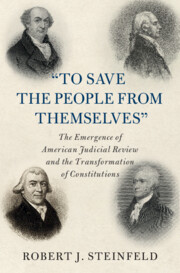 'To Save the People from Themselves'
'To Save the People from Themselves' Book contents
- “To Save the People from Themselves”
- Cambridge Historical Studies in American Law and Society
- “To Save the People from Themselves”
- Copyright page
- Dedication
- Contents
- Acknowledgments
- Introduction
- Part One Legislatures and Legislation under the First American Constitutions
- Part Two The Emergence of American Judicial Review: 1779–1787
- I The Emergence of American Judicial Review, 1779–1782
- II The Emergence of American Judicial Review, 1784–1787: Developing Judicial Review as a Check on Legislatures and on the People
- 6 The Reappearance of “Vertical” Judicial Review in the Case of Rutgersv.Waddington, New York, 1784
- 7 The Successful Battle to Establish Judicial Review in New Hampshire: The Ten Pound Act Cases, 1786–1787, and Their Aftermath
- 8 Judicial Review and Legislative Supremacy in Rhode Island: The Case of Trevett v. Weeden, 1786, and Its Aftermath
- 9 The Struggle Between Traditional Constitutionalism and the Constitution of Judicial Review in North Carolina: The Case of Bayard v. Singleton, 1786–1787, and Its Aftermath
- Part Three Judicial Review at the Federal Convention
- Index
6 - The Reappearance of “Vertical” Judicial Review in the Case of Rutgers v. Waddington, New York, 1784
from II - The Emergence of American Judicial Review, 1784–1787: Developing Judicial Review as a Check on Legislatures and on the People
Published online by Cambridge University Press: 17 September 2021
- “To Save the People from Themselves”
- Cambridge Historical Studies in American Law and Society
- “To Save the People from Themselves”
- Copyright page
- Dedication
- Contents
- Acknowledgments
- Introduction
- Part One Legislatures and Legislation under the First American Constitutions
- Part Two The Emergence of American Judicial Review: 1779–1787
- I The Emergence of American Judicial Review, 1779–1782
- II The Emergence of American Judicial Review, 1784–1787: Developing Judicial Review as a Check on Legislatures and on the People
- 6 The Reappearance of “Vertical” Judicial Review in the Case of Rutgersv.Waddington, New York, 1784
- 7 The Successful Battle to Establish Judicial Review in New Hampshire: The Ten Pound Act Cases, 1786–1787, and Their Aftermath
- 8 Judicial Review and Legislative Supremacy in Rhode Island: The Case of Trevett v. Weeden, 1786, and Its Aftermath
- 9 The Struggle Between Traditional Constitutionalism and the Constitution of Judicial Review in North Carolina: The Case of Bayard v. Singleton, 1786–1787, and Its Aftermath
- Part Three Judicial Review at the Federal Convention
- Index
Summary
Like the two earlier cases, Rutgers v. Waddington grew directly out of the events of the Revolutionary war. After being driven out of Boston in the spring of 1776, the British army adapted its strategy in America, determining to invade and occupy New York City, preparing the groundwork for an attempt to drive a military wedge between the New England colonies, parts of New York and the remainder of the country. Following a series of American defeats in the late summer and early fall of 1776, the British Army took possession of New York City and its immediate surroundings, where it remained for the next seven years, only departing in November, 1783 after the Definitive Treaty of Peace had been signed. Great numbers of Patriots fled the British occupation, abandoning the properties they owned in the city.
- Type
- Chapter
- Information
- 'To Save the People from Themselves'The Emergence of American Judicial Review and the Transformation of Constitutions, pp. 217 - 259Publisher: Cambridge University PressPrint publication year: 2021


